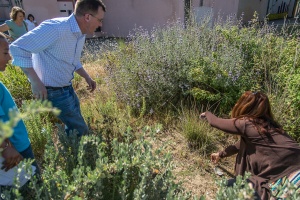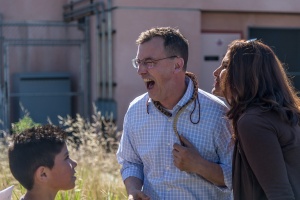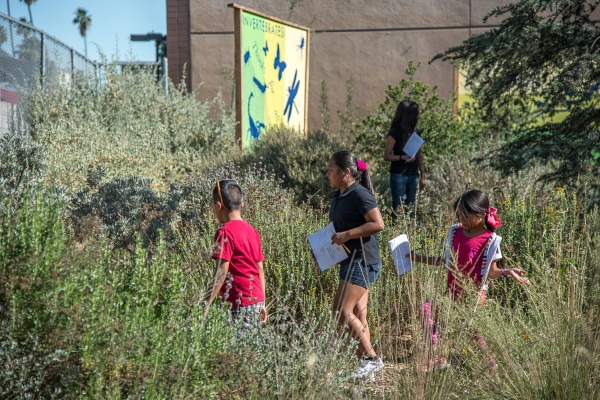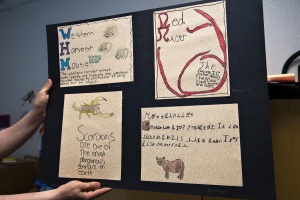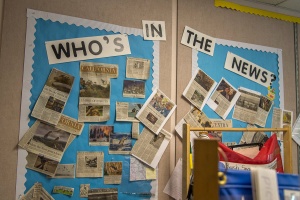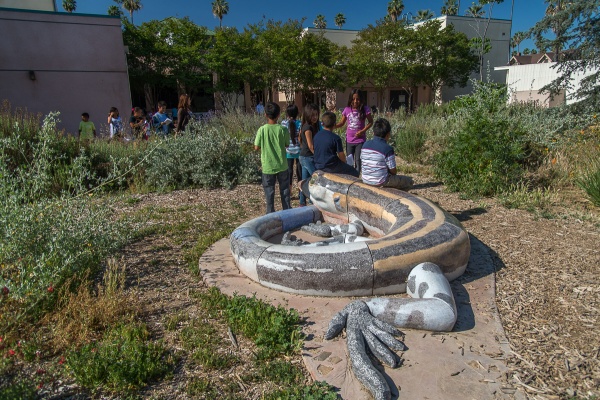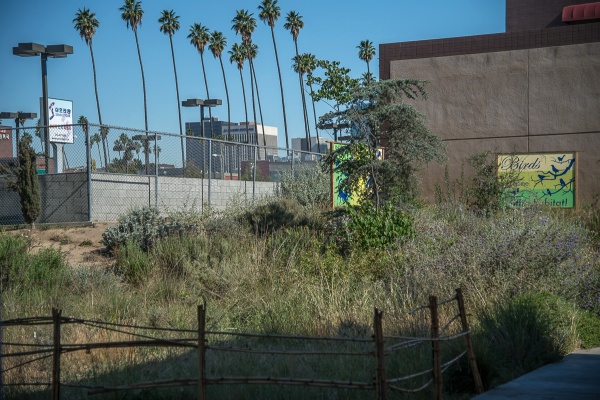Raising Birders – and More – at Leo Politi
The students were breathless. “Mr. Rumble! We saw something in the bush! Come quickly!” Bradley Rumble, principal at Leo Politi School near downtown Los Angeles was intrigued and followed the fourth graders out of the outdoor shady area into their once concrete-and-Bermuda-grass-plot-now-turned-native-plant-and-wildlife-habitat.
After all, there *could* be a critter out there. It’s not unusual in this 5,000 sq. ft. plot for students to encounter wildlife among the bladder pods, salt bush, buckwheat and coastal oaks. It’s been four years since the garden celebrated its “Plant Day” and the old saying “If you plant it, they will come” has rung true here in this urban neighborhood.
Notable birds like the Western meadowlark, Cooper’s hawks and yellow rumped warblers have been seen here along with the regulars: Little Leo (an Allen’s hummingbird that pays homage to the school moniker), carpenter bees, monarch butterflies and American kestrels. A while ago, students –and adults – thought they spied a slithering alligator lizard but that wasn’t completely verified.
So when the students dragged Rumble along the dirt paths that swirl and up around a large patch of sage, all eyes were on the *thing* that was crunching leaves and moving ever-so-slowly. Rumble bent down and the kids were whispering in excited anticipation. And then…
SKREE-FLOP! The rubber snake leapt out and made everyone – but especially Rumble – holler. Shrieks of laughter erupted and Rumble good-naturedly embraced the prank. “Oh, you guys are good! That is a classic!” he told them as students grinned ear to ear. Fourth grade teacher Linda Dowell explained that this joke had been planned for a long time. “Welcome to our school!” she exclaimed.
Indeed, the culture at Leo Politi is inviting on many levels – it’s a school that many adults probably wish they could have attended back in their day. This outdoor habitat, used practically every day by students of all ages and their teachers, is the connector that fuels much of the education query…but that’s just the beginning.
After the excitement of the joke wore off, the students are back to their booklets, making observations, writing and drawing pictures of their favorite plants and checking the micro-habits (carefully placed rock piles) and bee house for new residents.
Later, students may spend time in the Audubon Classroom where cross curriculum studies connect art, poetry, current events to science, nature and local wildlife. Second graders are learning such vocabulary words as: limited exposure, carcass, toxic element and extinction. Older students study the history of scientific drawings that include cave drawings, illuminated manuscripts and the bathysphere. Here, studying the intricacies and diversity of the natural world isn’t just for youngsters – it’s a serious endeavor that takes its cue from the learning laboratory growing in their own back yard.
At the school, science scores have gone from 9 % proficient, 0 % advanced in 2009 to a healthy average of 47 % proficient/advanced. In 2005, 11 students were identified as gifted; in May 2013, 95 were in the gifted program, more than 10 percent of the school.
“What we have here is pride of ownership for these students right on their campus,” says Rumble. “They have gained specialized knowledge of the natural world…and once they realize they can be experts in one thing, they can then see themselves as experts in others ways.”
Third grader Francisco is one such expert. Clutching his own notebook and a copy of Sibley’s Guide to Birds, he’s practically memorized the pages and taxonomy of area birds, not to mention how bird species differ. On a recent field trip, he and Rumble discussed the difference between the Western and Eastern meadowlarks. “In Arizona I saw a painted bunting and I want to travel and see birds,” he explains. “I like spending most of my time out here.”
It did take a village to create this outdoor habitat. L.A. Audubon worked with the school to receive aSchoolyard Habitat Restoration Program grant through the U.S. Fish & Wildlife Service. They also received a grant from Toyota’s Together Green program. Restoration ecologist Margot Griswold and the students at Dorsey High School were on board to help students/faculty study soil samples and determine the school’s ecological location in the LA watershed (coastal sage scrubland) along with prepping the soil and final planting. Parental involvement was instrumental.
“Native plants are a lot of work to establish,” says Griswold who regularly visits the school to see what’s growing – and that’s not just the plants, but the students also. “We are starting to see the links between providing students these kinds of learning opportunities to higher education,” she says explaining how a recent Politi grad has now enrolled at Dorsey High and joined the Eco Club.
Griswold is quick to point out that not every student who graduates will want to pursue a career in sciences, but that “giving them this kind of exposure will provide them with not just an appreciation of nature but will allow them to be open to the world around them.”
Griswold is part of the LAUSD Instructional Schoolyards Task Force that will next month offer recommendations on how schools can create outdoor learning centers, much in the vein of what goes on at Leo Politi. Maybe one day school habitat gardens will be a normal part of every school’s campus, just like swing sets and lunch tables.
Currently, 400 out of 800 schools in the Los Angeles Unified School District has some kind of green space, be it a vegetable plot, garden or boxed planting area. Chief Facilities Executive Mark Hovatter is excited about the way schools are incorporating gardens in Los Angeles but says that many of these habitats are dependent on certain volunteers. “The problem comes when those volunteers move on, and then the garden disappears,” he says. A new program Sustainable Environment Enhancement Development for Schools (SEEDS) kicking off this June aims to provide schools with resources as well as partnerships to keep green spaces going.
Overall, Rumble shares his vision for Los Angeles schools that, given the success at Leo Politi, doesn’t seem that far-fetched. “Why couldn’t all the schools in Los Angeles become an urban flyway for migrating birds?” he wonders. “Every school in every neighborhood. That would really be remarkable. We could all be connected with the birds.”
– Brenda Rees, editor

